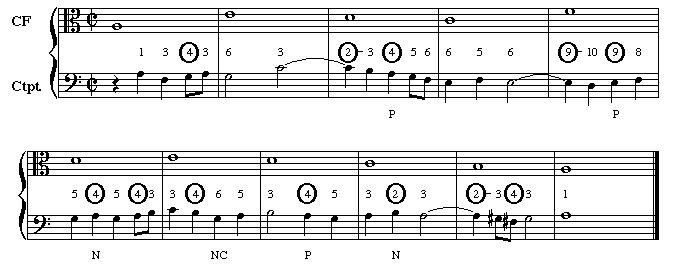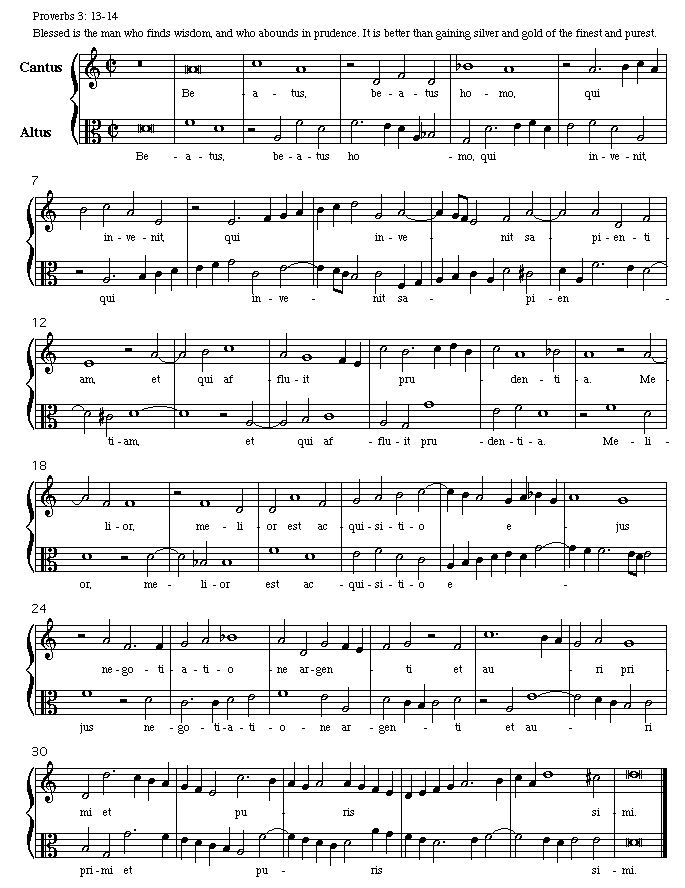SOUND PATTERNS
A Structural Examination of Tonality, Vocabulary, Texture,
Sonorities, and Time Organization in Western Art Music
by PHILLIP MAGNUSON

BASIC RULES FOR SPECIES COUNTERPOINT
Chapter 10. Species V in Two Voices
10.1 INTEGRATION OF SPECIES
Species V is the integraton of Species I through IV into one exercise, as in the example above. The method of doing this requires balance of each species, and a useful guide to ensure this variety is this:
| Species I | wholenotes: | only one, in the last measure |
| Species II | half notes: | no more than three in succession |
| Species III | quarter notes: | no more than eight in succession |
| Species IV | tied half notes: | no more than two pairs in succession |
The melodic and contrapuntal principles for each species apply for the length of time that each is used, and upon entering and leaving that species.
10.2 SPECIAL CONSIDERATIONS FOR SPECIES V
-
Species III and IV can be combined to create a dotted half note or a half tied to a following quarter note. Each must begin on a strong beat, and a quarter note can never be tied to a following half note.
In measure 2, notice how the suspension resolves on the second quarter note of the measure instead of beat 2. In measure 3, notice that there really is no suspension created, but that it works like the rhythm of the measure before.

-
Eighth notes may be added as an extra layer of embellishment,
but they must conform to the following rules:
- They must occur in stepwise pairs.
- They must be approached and left by step.
- They must occur on the "and's" of beats 1 or 2.
- No more than one pair may be used in a given measure
This example shows the correct uses of eighth notes. Dissonance does not have to be explained. but parallel perfect consonances still must be avoided.

INTERLUDE
How many errors does the counterpoint below contain?

A
3
errors
| B
4
errors
| C
5
errors
| D
6
errors
| E
7
errors
|
10.3 EXAMPLE OF COUNTERPOINT IN SPECIES V

Note the relatively equal distribution of each species.
ASSIGNMENTS:
SYNTHESIS
Using an assigned cantus firmus, write a soprano counterpoint
above, and a bass counterpoint below, in Species V.
Be careful to pay attention to all the principles of each species as you use it. In Species V, the quality of the melodic line is always the most important issue. Include at least 3 pairs of eighth notes.
ANALYSIS
A cantus firmus is not always used in contrapuntal compositions. Analyze the piece below written by Orlando di Lasso in the sixteenth century. Label the intervals, and indicate which species is being used in any given measure. Notice the use of musica ficta, especially the B-flats. They are not used for a cadence as other musica ficta are, but to avoid melodic tritones (the diabolus in musica). Also note that the two voices take turns imitating each other.

Cantus firmi
1. |  |
|---|
2. |  |
|---|
3. |  |
|---|
4. |  |
|---|
5. |  |
|---|
6. |  |
|---|
7. |  |
|---|
8. |  |
|---|
9. |  |
|---|
10. |  |
|---|
11. |  |
|---|
12. |  |
|---|
Links to chapters in this unit:
Link to previous unit: FUNDAMENTALS
Link to next unit: DIATONIC PROCEDURES I: Harmonic Dimensions
Copyright © 2008-2009 by Phillip Magnuson.
Content on this website is licensed under a Creative Commons License.
















